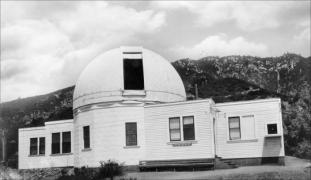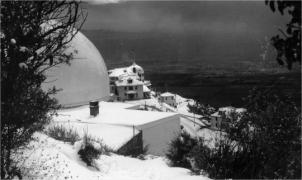 |
| The world famous Lowe Observatory atop Echo Mountain |
Professor T.S.C. Lowe and his Mountain Observatory
By Paul Rippens
 |
| The world famous Lowe Observatory atop Echo Mountain |
Millions of Americans have long had a fascination with our solar system.. One of the early Americans who became infatuated with the heavens was Professor Thaddeus S.C. Lowe. Lowe, who is best remembered for his
Civil War exploits, creating the World’s first military air force. He sold his "Balloon Corps" idea to President Abraham Lincoln, and made a number of successful balloon flights over northern Virginia, observing Confederate lines for the Union Army.Lowe’s own memoirs tell how he "would lie in a field or sit astride a picket fence, gazing for hours at the great white clouds hanging like banners or floating slowly across the skies." These observations would one day help him in his ballooning and aerial navigation. Lowe stated that "from living in high altitudes, I had observed that there are often very different air currents in the valleys from those which exist in the upper atmosphere." What Lowe was observing were the jet streams that moved the clouds across the skies.
Upon his arrival in Pasadena in 1887, Lowe had the money necessary to live comfortable and to follow his interests in astronomy. He built a 24,000 square foot residence at 995 South Orange Grove Avenue. The top floor of the tower on one side of the home was nearly 75 feet high, and held a six-inch reflecting telescope. This allowed Lowe to continue his quest for more information on the stars and furthered his interest in establishing much larger astronomical observatories.
On April 6, 1892, Lowe accompanied President Charles W. Eliot of Harvard University and a group of distinguished gentlemen from Pasadena and Los Angeles to Mount Wilson. The party included Walter Raymond, proprietor of the Raymond Hotel; Dr. A.E. Winship of Boston, editor of the Journal of Education and the Daily Traveler; W. S. Severance of Los Angeles; Judge Benjamin Eaton of South Pasadena; Judge H.W. Magee, Superintendent Will S. Monroe of the Pasadena public schools; and photographer W.H. Hill. The Los Angeles Times reported on April 9, 1892 that:
The trip was not for pleasure only but had to do with a matter of no less importance than the establishment of a photographic telescope on Mt. Harvard, one of the most prominent peaks of the Sierra Madres. The trip was planned by Mr. Raymond, in order to afford President Eliot opportunity to inspect the ground in person.
While on
Mt. Wilson, the group visited the site of the first observatory on the mountain established in 1889. The observatory lasted only eighteen months after which the 13-inch telescope was removed. Professor Lowe planned to establish a grand hotel on the side when he completed his railway to Mr. Wilson, a plan that never materialized.Although Professor Lowe had made quite a name for himself through his various exploits, he never gave up his love of astronomy. He had known of Dr. Lewis Swift of Rochester, New York, a noted astronomer who had been the recipient of many distinguished honors, including three gold medals by the Imperial Academy of Science at Vienna for comet discoveries in 1877, 1878, and 1879. A wealthy citizen of Rochester had presented Swift with a magnificent sixteen-inch Alvan Clark refracting
telescope and a fine observatory to house it. Here Swift carried on his work from 1886 to 1894. Unfortunately, Rochester grew, and it was not long before the observatory was surrounded by homes and many city lights, hindering Dr. Swift in his favorite activity of hunting comets.Professor Lowe heard of the difficulty and invited Dr. Swift to come to California. He offered to move Swift’s whole observatory and rebuild it on Echo Mountain at an elevation of four thousand feet with a great sweeping view of the heavens from the North Star to the southern horizon. Dr. Swift accepted Professor Lowe’s offer, and Lowe set about constructing a new observatory on Echo Mountain in 1893. Swift’s telescope, a 16-inch
Brashear Telespectroscope Polariscope, along with Micrometers, Driving Clock, and other accessories, manufactured in 1882 by Alvan Clark & Sons, of Cambridge, Massachusetts was transported to Echo Mountain and first used in 1894.Swift continued his work at Echo Mountain until August 11, 1900 when, at the age of 80, his eyesight began to fail. He was replaced by Professor Edgar Lucien Larkin who would carry on Dr. Swift’s work for the next 24 years. Swift’s last days in the observatory he loved so much were very sad. As Professor Larkin led him down the path from the observatory for the last time, the old man broke into tears. He left all his books behind for they were of no use to someone who was blind. Dr. Swift returned to his old home in marathon, New York, where he died on January 5, 1913, at the age of 92.
 |
| A winter photo of the Lowe Observatory on Echo Mountain |
Professor Larkin unpacked his belongings, which had been shipped from Illinois. As he toiled he looked out the small window and observed a visitor making his way towards the building. The visitor was Thaddeus Lowe who had returned to Echo Mountain to meet Larkin. They became friends during their several hour visit, while Lowe discussed him dream of yet another observatory higher in the mountains. Like Swift, Larkin was a self-made and largely self-educated man. In 1879 he built a private observatory at New Windsor, Illinois, equipped with a 6-inch Clark Refractor. This telescope was transferred in 1888 to Knox College at Galesburg, Illinois, where Larkin was in charge of the observatory until 1895.
At Echo Mountain, he devoted much of his time to public nights for the thousands of visitors who came on the scenic railway. After Professor Lowe lost his railway due to financial difficulties, the Pacific Electric Railway Co. purchased the line and hotels in 1902 and continued to operate them.
In 1904, a well-known astronomer, W.H. Pickering, spent several months at the Echo Mountain Observatory using the 16-inch telescope to continue his studies of the moon and Jupiter’s satellites.
Professor Larkin was sometimes assisted by Charles S. Lawrence, a photographer hired by the Pacific Electric Company. Lawrence took an active part in the public demonstrations held at the observatory, and after Larkin’s death in 1924, he became the director of the Echo Mountain Observatory.
Following Professor Larkin’s death, his son Ralph desired to carry out his father’s wishes that his ashes be scattered over the summit of what is now known as Mt. Larkin, located near Inspiration Point. Ralph called upon Charles Lawrence to assist him in this task and upon reaching the top of the mountain, Larkin’s son could not carry out the deed. He turned to Lawrence and said "Charles, I can’t do it. Will you do it for me?" Obligingly, Lawrence took the box of ashes and scattered them around the top of the small peak. "Thus ended, to my sorrow, our many pleasant years of close association and mutual devotion," Lawrence later stated.
Fire became a constant enemy of the Mt. Lowe Railway. A fire on February 5, 1900 destroyed the magnificent Echo Mountain House. On December 9, 1905, a severe windstorm and fire devastated the mountaintop, destroying every building except the observatory. The flames came so close that the 16-inch mirror was removed from the telescope and lowered into a water reservoir for safety. But the end of the observatory came not from fire but from a windstorm in 1928. Lawrence was inside the observatory when winds of hurricane velocity literally blew the building apart. He was not injured in this frightening experience but the observatory, like the rest of the buildings on Echo Mountain, was gone forever.
Although Lowe’s observatory did not survive, the 16-inch refractor has. In 1941, the University of Santa Clara, California bought it from the Southern Pacific Railway Company, and it remains in use today in a small observatory on the Santa Clara campus.
Professor Lowe never was able to continue his venture and realize what would have been another great accomplishment. It was his intention to continue his railway from the side of Ye Alpine Tavern to the summit of Mount Lowe, where another hotel was to be built. Plans had been made to move the existing observatory from Echo Mountain to the peak of Mount Lowe. The Professor had even more ambitious ideas, for he then planned to construct a great cable aerial tramway from the summit to Mr. Lowe high over the deep canyons to the summit of San Gabriel Peak. Lowe called this six thousand foot mountain "Observatory Peak" and he planned to build the largest observatory in the world and a sanctuary where men of science might live, expense free, to carry on their investigations without annoyance from the outside world.
Today little remains of Professor Lowe’s railway and observatory, only foundations and rusting metal. The Professor’s idea of making Echo Mountain and Observatory Peak the astronomical center of the world never materialized but the work continues at Mount Wilson and other observatories throughout the world. Perhaps Professor Lowe was ahead of his time, or perhaps the work started by him was meant to be continued by others. His ideas let to rich discoveries in many fields, but few remember him for his efforts to further the field of astronomy.
The Echo Mtn. Echoes and Land-Sea Discovery Group would like to extend their thanks to Paul Rippens for contributing his work to the paper. Paul Rippens is retired as Chief Forester of the County of Los Angeles Fire Department and lives in San Dimas, California. Paul has written articles for the Branding Iron, the quarterly publication of the Los Angeles Corral of the Westerners, and the Dogtown Territorial Quarterly. Recently Paul published his first book, Historic Mount Lowe a Hiker's Guide to the Mount Lowe Railway.
Send email to Echowebmaster@aaaim.com to report any problems.
Last modified: February 12, 1999
No part of this paper may be
reproduced in any form without written permission from:
Jake Brouwer
All articles and photos were provided by:
Land-Sea Discovery Group
Copyright © 1999